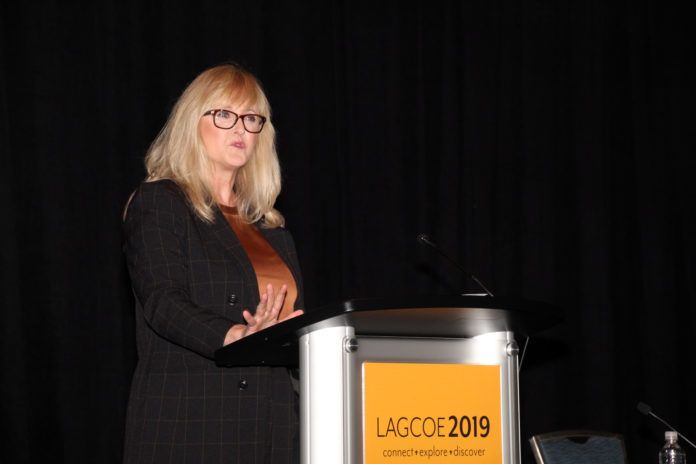Chevron Senior Executive Kimberly McHugh says the pace of technology is accelerating as extracting oil from Texas and Louisiana shale plays gets more difficult and offshore oil seeks to do more with less.
McHugh, who oversees global drilling and completions at Chevron, made those comments last week to a select gathering of oil and gas executives at the opening keynote breakfast at LAGCOE 2019.
“Since 2011, a third of the production in the U S has come from the shales, going from about 5.7 million barrels a day to 11.5 in 2018,” she told those gathered. “These wells are getting harder to drill. They went from vertical to horizontal, 5,000 foot laterals to pushing between 10,000 and 20,000 foot laterals. And it’s taking more water to frack, so we’ve got to find ways to frack without the amount of water.”
There are other strains, such as increasing sand volumes and supply chain limitations. Meanwhile, offshore is grappling with its own problems. “With an unconventional well, you drill it and it’s producing within 40 days. With offshore, it can be 10 years from the time the oil is discovered.”
McHugh predicts technology will save the day, pointing to the Chevron Decision Support Center as an example. The center can monitor West Texas wells remotely from Houston. “From a well-control standpoint, we can alert when we’ve seen any changes, contact the rig so they can make adjustments,” she added. Chevron also uses Artificial Intelligence to analyze voluminous amounts of well data and GPS to monitor the location of trucks in the field.
“We’re getting smarter faster,” McHugh said, “because we’ve got people making standardized decisions instead of spread across a group, and we’re improving our performance dramatically.”
Next up for Chevron is the incorporation of augmented reality and smart technologies in the field. “We can have a subject matter expert sitting in an office looking at exactly what that individual is looking at in the field,” she noted. “With augmented reality, I can have a subject matter expert look at a damaged piece of equipment or tool.” Smart devices can also monitor heat exposure of employees and warn an employee when they’re in danger.
LAGCOE’s three-day event drew 17,000 attendees from 49 states and 40 countries, and serves a platform for the industry’s innovators to present cutting-edge technologies, equipment and services for both onshore and offshore markets. LAGCOE Executive Director Angela Cring said hosting the event in New Orleans, which for years the event was based in Lafayette, reflects LAGCOE’s efforts to better serve the industry’s needs by adapting and reaching out to a broader audience.
“New Orleans is home to many oil and gas operators who are key decision makers,” Cring says. “This makes LAGCOE 2019 the natural bridge between the two cities that are vital to our industry. The energy industry is changing, and we must evolve and change with it.”



